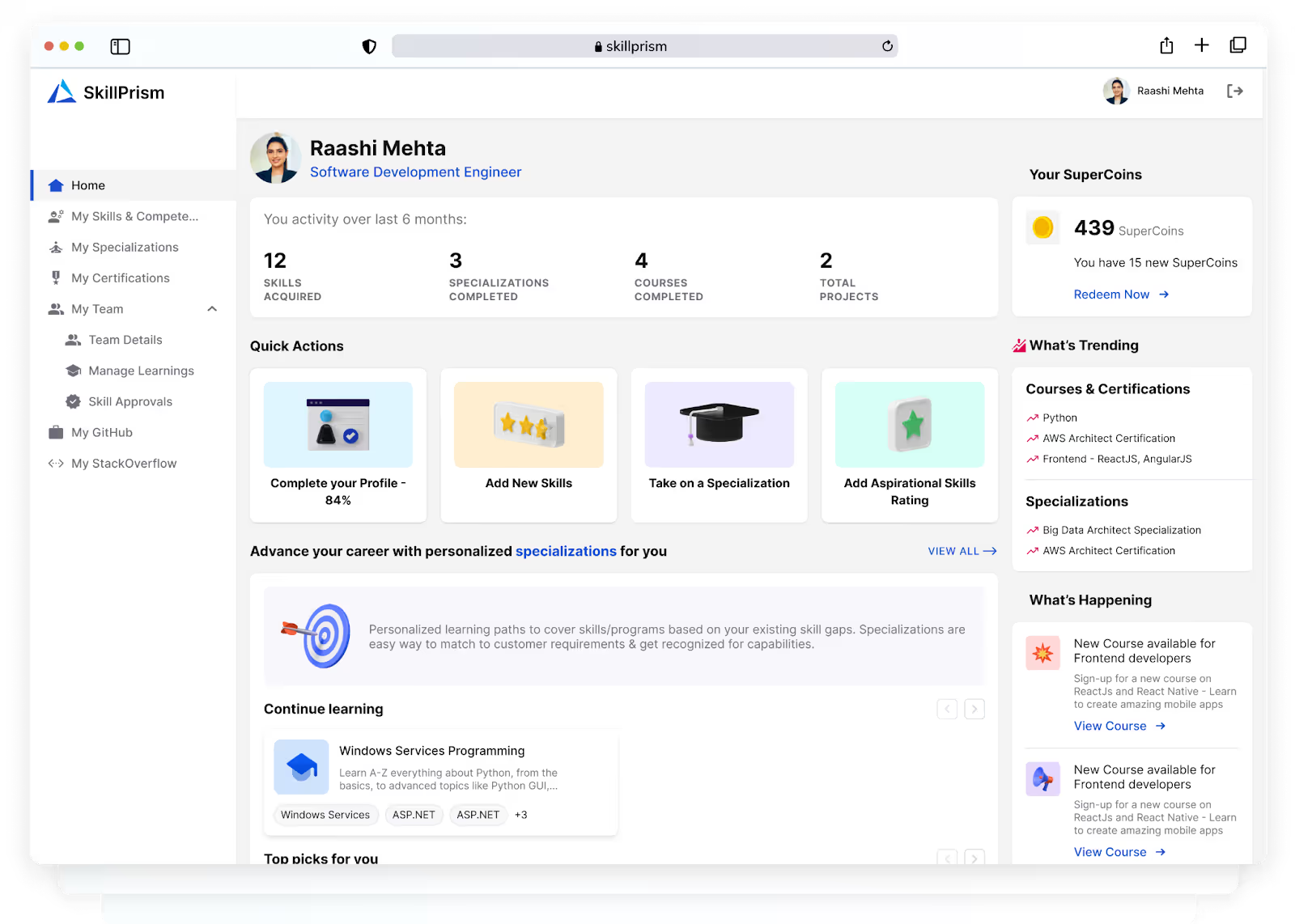
The landscape of enterprise technology is changing everyday, but one factor has emerged as a critical determinant of success: skills intelligence. As businesses navigate the complexities of digital transformation, the ability to correctly assess, develop, and leverage the skills of their workforce has become a strategic imperative.
This article delves into the realm of skills intelligence, exploring its essence, significance, and the transformative impact it can have on workforce planning and organizational performance.
What is Skills Intelligence?
Skills intelligence is the process of gathering, analyzing, and applying data on employee skills to optimize workforce planning, training, and talent management. This approach helps organizations identify skill gaps, assess workforce capabilities, and align employee skills with business goals, improving overall productivity and strategic alignment.
By harnessing the power of data and analytics, skills intelligence enables organizations to make informed decisions about talent acquisition, development, and deployment, ensuring they have the right people with the right skills at the right time.
Why Skills Intelligence Matters More than Ever?
Skills intelligence today has become an indispensable tool for following reasons:
1. Technological Disruption
The pace of technological advancements is relentless, constantly introducing new tools and methodologies. Skills intelligence enables organizations to proactively identify skill gaps and equip their workforce with the necessary competencies to stay ahead of the curve.
2. Talent Scarcity
The demand for highly skilled professionals in emerging technologies often outstrips the supply. Skills intelligence empowers organizations to optimize their existing talent pool, nurturing and developing the required skills internally, reducing dependence on external hiring.
3. Workforce Agility
Today, organizations need to rapidly adapt to changing market conditions and customer demands. Skills intelligence facilitates workforce agility by providing visibility into the available skill sets, enabling strategic redeployment and cross-functional collaboration.
Key Components of Skills Intelligence
Effective skills intelligence relies on three critical components:
1. Skills Taxonomy
A comprehensive and standardized skill taxonomy that defines and categorizes the skills relevant to an organization's operations and strategic objectives.
2. Skills Assessment
A robust mechanism for evaluating and documenting the skills possessed by individual employees, leveraging various assessment methods such as self-assessments, peer evaluations, and performance data.
3. Skills Analytics
The application of advanced data analytics and machine learning techniques to derive actionable insights from the collected skills data, enabling informed decision-making and strategic workforce planning.
The Evolution of Skills Intelligence
How it Differs from Traditional Skills Assessments
Traditional skills assessments often relied on manual processes, such as self-reported surveys or subjective evaluations, which were prone to biases and inaccuracies. In contrast, modern skills intelligence leverages cutting-edge technologies to provide a more comprehensive and objective understanding of an organization's skill landscape.
From Manual Skills Tracking to AI Powered Insights
The advent of artificial intelligence (AI) and machine learning (ML) has revolutionized the way skills intelligence is approached. AI-powered systems can analyze vast amounts of data, including employee performance metrics, project outcomes, and skill utilization patterns, to generate accurate skill profiles and predictive models. These insights enable organizations to identify emerging skill gaps, forecast future talent needs, and develop targeted upskilling and reskilling initiatives.
Role of Data Analytics and Machine Learning
Data analytics and machine learning play a pivotal role in skills intelligence by enabling the following capabilities:
- Skill Extraction: Natural language processing (NLP) techniques can automatically extract and categorize skills from various data sources, such as job descriptions, resumes, and project documentation.
- Skill Clustering: Machine learning algorithms can identify patterns and relationships between skills, enabling organizations to understand skill adjacencies and potential career paths.
- Predictive Modeling: By analyzing historical data and incorporating external factors, such as industry trends and market dynamics, predictive models can forecast future skill demands and inform strategic workforce planning decisions.
The Business Impact of Skills Intelligence
The strategic implementation of skills intelligence can yield significant benefits for organizations, including:
1. Improved Talent Acquisition
By identifying precise skill requirements and mapping them to the available talent pool, organizations can streamline their recruitment efforts, attracting and hiring the right candidates more efficiently.
2. Optimized Talent Development
Skills intelligence provides insights into individual and organizational skill gaps, enabling targeted learning and development initiatives that align with business objectives and employee career aspirations.
3. Enhanced Workforce Utilization
With a clear understanding of the available skill sets, organizations can optimize resource allocation, ensuring that the right talent is deployed on the right projects, maximizing productivity and minimizing skill mismatches.
4. Increased Agility and Adaptability
By proactively identifying emerging skill trends and anticipating future talent needs, organizations can remain agile and responsive to market shifts, positioning themselves for long-term success.
5. Reduced Talent Attrition
By fostering a culture of continuous learning and career growth opportunities, skills intelligence can contribute to higher employee engagement and retention, mitigating the risk of talent attrition.
Implementing Skills Intelligence in Tech
Implementing skills intelligence in the tech industry requires a strategic and systematic approach. Here are some key considerations:
1. Establish a Robust Skills Taxonomy
Develop a comprehensive and industry-specific skills taxonomy that accurately captures the diverse and rapidly evolving skill sets required in the tech sector.
2. Leverage Existing Data Sources
Utilize existing data sources, such as employee profiles, project documentation, and performance evaluations, to kick-start the skills intelligence initiative.
3. Integrate AI and ML Technologies
Invest in AI and ML technologies that can automate skill extraction, clustering, and predictive modeling, ensuring scalability and accuracy.
4. Foster a Culture of Continuous Learning
Encourage a mindset of continuous learning and skill development within the organization, empowering employees to actively contribute to and benefit from the skills intelligence initiative.
5. Align with Strategic Objectives
Ensure that the skills intelligence strategy is closely aligned with the organization's overall business objectives, enabling effective workforce planning and resource allocation.
6. Collaborate with Stakeholders
Engage cross-functional stakeholders, including HR, business leaders, and subject matter experts, to ensure a comprehensive and holistic approach to skills intelligence implementation.
{{blog-widget}}
Leverage Skills Intelligence and Plan Your Workforce Effectively with Prismforce
Prismforce, a leading provider of skills intelligence solutions, offers a comprehensive platform that empowers organizations to unlock the full potential of their workforce. Prismforce uses advanced AI and ML technologies, helping organizations to gain deep insights into their skill landscape, identify skill gaps, and develop targeted strategies for talent intelligence, acquisition, development, and deployment.

In conclusion, mastering skills intelligence is no longer an option but a necessity for leaders in the enterprise tech sector. By embracing this strategic approach, organizations can gain a competitive edge, fostering a highly skilled and adaptable workforce capable of navigating the complexities of digital transformation. Embark on the journey of skills intelligence today and position your organization for sustainable success in the ever-evolving tech landscape.





